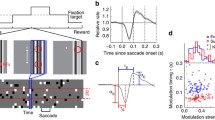Abstract
Neurons in monkey medial superior temporal cortex (MST) respond to optic flow stimuli with early phasic, tonic, and after-phasic response components. In these experiments we characterized each response component to compare its potential contributions to visual motion processing. The early responses begin 60–100 ms after stimulus onset and last between 100 and 250 ms, the tonic responses begin 100–300 ms after stimulus onset and last for as long as the evoking stimulus persists, and the after-responses begin about 60 ms after the stimulus goes off and last for 100–350 ms. A neuron’s tonic responses were evoked by specific optic flow stimuli: over two-thirds of the 264 neurons showed tonic responses evoked by two to five stimuli, whereas only 15% responded to either all or none of the stimuli. The tonic responses continued with stimulus presentations as long as 15 s, with their directional preferences being maintained throughout stimulation. However, the tonic response to a given stimulus was seen to change in amplitude when it was presented in random sequence with different sets of other stimuli. Thus, the tonic responses might convey substantial information about optic flow patterns, which continue with prolonged stimulation, but can be modified by the visual context created by other visual motion stimuli. Only about one-third of the 264 neurons had early responses that were selective for specific stimuli. In neurons yielding at least one early response, that neuron was most often activated by all the visual motion stimuli. After-rsponses occurred in only half the neurons, but they were more often specifically related to particular optic flow stimuli, regardless of whether those stimuli had evoked tonic excitatory or tonic inhibitory responses. The presence of early and after-responses complicates the interpretation of activity evoked when one stimulus immediately follows another. However, under those conditions, early responses and after-responses might contribute to signaling changes in the ongoing pattern of optic flow. We conclude that several components of MST responses should be recognized and that they potentially play different roles in the cortical analysis of optic flow. Tonic responses show the greatest specificity for particular optic flow stimuli, and possess characteristics which make them suitable neuronal participants in self-movement perception.
Similar content being viewed by others
Author information
Authors and Affiliations
Additional information
Received: 1 April 1996 / Accepted: 1 October 1996
Rights and permissions
About this article
Cite this article
Duffy, C., Wurtz, R. Multiple temporal components of optic flow responses in MST neurons. Exp Brain Res 114, 472–482 (1997). https://doi.org/10.1007/PL00005656
Issue Date:
DOI: https://doi.org/10.1007/PL00005656




